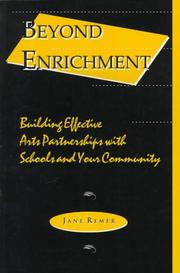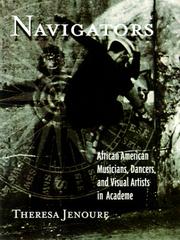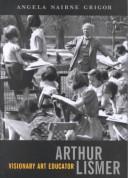| Listing 1 - 10 of 11 | << page >> |
Sort by
|

ISBN: 1879903245 Year: 1996 Publisher: New York : ACA Books,
Abstract | Keywords | Export | Availability | Bookmark
 Loading...
Loading...Choose an application
- Reference Manager
- EndNote
- RefWorks (Direct export to RefWorks)
Artists as teachers --- Arts --- Community arts projects --- Study and teaching
Book
ISBN: 1281104698 9786611104696 908790326X Year: 2008 Publisher: Rotterdam ; Taipei : Sense Publishers,
Abstract | Keywords | Export | Availability | Bookmark
 Loading...
Loading...Choose an application
- Reference Manager
- EndNote
- RefWorks (Direct export to RefWorks)
Being with A/r/tography is a collection of essays that explain and exemplify the arts-based research methodology called a/r/tography. Edited by four scholars who are artists, researchers, and teachers (a/r/tographers), this book is a methodology book for practitioners in arts-based educational research. In addition to an introductory essay which contextualizes and theorizes the methodological framework of a/r/tography, the book is divided into three main thematic sections that are integral to a/r/tographical research: (1) self-study and autobiography; (2) communities of a/r/tographic practice; (3) ethics and activism. The book concludes with a consideration of issues related to assessment, validity, and interpretation. Being with A/r/tography will be an excellent core text in graduate courses that focus on arts-based educational research, as well as a valuable text in pre-service teacher education programs. The book will also be significant for qualitative research courses in all the social sciences and the health sciences, including communication studies, nursing, counseling psychology, and arts therapy. The book provides a clear and comprehensive introduction to a/r/tography. Even though a/r/tography as a research methodology is relatively new in the scholarly field, Being with A/r/tography spells out how scholarly practitioners who are artists and researchers and teachers have been pursuing this kind of research for a long time.
Artists as teachers. --- Education --- Art in education. --- Research.

ISBN: 079144354X 0791443531 Year: 2000 Publisher: Albany State University of New York Press
Abstract | Keywords | Export | Availability | Bookmark
 Loading...
Loading...Choose an application
- Reference Manager
- EndNote
- RefWorks (Direct export to RefWorks)
Book
ISBN: 9004392858 9789004392854 9004392858 Year: 2020 Publisher: Leiden ; Boston : Brill Sense,
Abstract | Keywords | Export | Availability | Bookmark
 Loading...
Loading...Choose an application
- Reference Manager
- EndNote
- RefWorks (Direct export to RefWorks)
To expand the possibilities of “doing arts thinking” from a non-Eurocentric view, Artistic Mentoring as a Decolonizing Methodology: A Collaborative Painting Ethnography with Maya Artists Pedro Rafael González Chavajay and Paula Nicho Cúmez is grounded in Indigenous perspectives on arts practice, arts research, and art education. Mentored in painting for eighteen years by two Guatemalan Maya artists, Kryssi Staikidis, a North American painter and art education professor, uses both Indigenous and decolonizing methodologies, which involve respectful collaboration, and continuously reexamines her positions as student, artist, and ethnographer searching to redefine and transform the roles of the artist as mentor, historian/activist, ethnographer, and teacher. The primary purpose of the book is to illuminate the Maya artists as mentors, the collaborative and holistic processes underlying their painting, and the teaching and insights from their studios. These include Imagined Realism, a process excluding rendering from observation, and the fusion of pedagogy and curriculum into a holistic paradigm of decentralized teaching, negotiated curriculum, personal and cultural narrative as thematic content, and the surrounding visual culture and community as text. The Maya artist as cultural historian creates paintings as platforms of protest and vehicles of cultural transmission, for example, genocide witnessed in paintings as historical evidence. The mentored artist as ethnographer cedes the traditional ethnographic authority of the colonizing stance to the Indigenous expert as partner and mentor, and under this mentorship analyzes its possibilities as decolonizing arts-based qualitative inquiry. For the teacher, Maya world views broaden and integrate arts practice and arts research, inaugurating possibilities to transform arts education.
Painting --- Decolonization. --- Artists as teachers. --- Study and teaching --- Social aspects. --- González Chavajay, Pedro Rafael. --- Cúmez, Paula Nicho,
Book
ISBN: 9781622731251 1622731255 9781622731077 1622731077 9781622732975 1622732979 Year: 2017 Publisher: Wilmington, Delaware, United States
Abstract | Keywords | Export | Availability | Bookmark
 Loading...
Loading...Choose an application
- Reference Manager
- EndNote
- RefWorks (Direct export to RefWorks)
"Historical inquiry forms the foundation for much research undertaken in art education. While traversing paths of historical investigation in this field we may discover undocumented moments and overlooked or hidden individuals, as well as encounter challenging ideas in need of exploration and critique. In doing so, history is approached from multiple and, at times, vitally diverse perspectives. Our hope is that the conversations generated through this text will continue to strengthen and encourage more interest in histories of art education, but also more sophisticated and innovative approaches to historical research in this field. The overarching objective of the text is to recognize the historical role that many overlooked individuals--particularly African Americans and women--have played in the field of art education, and acknowledge the importance of history and historical research in this digital age. This text opens up possibilities of faculty collaborations across programs interested in history and historical research on a local, national, and international level. By assembling the work of various scholars from across the United States, this text is intended to elicit rich conversations about history that would be otherwise beyond what is provided in general art education textbooks." -- Publisher's description
Art --- Women art teachers --- African American art --- African American artists as teachers. --- Study and teaching --- History. --- History. --- Study and teaching --- History.
Book
ISBN: 0585336741 9780585336749 1438407882 Year: 2000 Publisher: Albany, NY State University of New York Press
Abstract | Keywords | Export | Availability | Bookmark
 Loading...
Loading...Choose an application
- Reference Manager
- EndNote
- RefWorks (Direct export to RefWorks)
African American artists as teachers --- African American artists --- African American arts --- Fine Arts - General --- Art, Architecture & Applied Arts --- Afro-American arts --- Arts, African American --- Negro arts --- Ethnic arts --- Afro-American artists --- Artists, African American --- Negro artists --- Artists --- Afro-American artists as teachers --- Teachers

ISBN: 1282860127 9786612860126 0773569812 9780773569812 0773522956 9780773522954 9781282860124 661286012X Year: 2002 Publisher: Montréal, Que. Ithaca, N.Y. McGill-Queen's University Press
Abstract | Keywords | Export | Availability | Bookmark
 Loading...
Loading...Choose an application
- Reference Manager
- EndNote
- RefWorks (Direct export to RefWorks)
Arthur Lismer, well-known member of the Group of Seven, was also one of Canada's most innovative educators. Using previously untapped correspondence and papers as well as interviews with Lismer's teaching colleagues, child students, and art students, Angela Nairne Grigor examines Lismer's Arts and Crafts Movement background in his native England, the evolution of the humanistic ideas and ideals that guided his work as both an artist and a teacher, and his international influence as an educator. She gives a vivid portrait of his approach to teaching in an illustrious fifty-year career that took him from Toronto to Halifax, Montreal, New York, Australia, New Zealand, and South Africa, and during which he played a pivotal role in the development of some of Canada's most important art schools and museums. Lismer pioneered new progressive ideas in art education through his work with children as educational supervisor at the Art Gallery of Toronto and, later, at Montreal's Museum of Fine Arts. In exploring Lismer's development as an educator, Grigor traces the history of art education in twentieth-century Canada and charts changing attitudes towards children and art. Lismer emerges as an artist with a social conscience who captured the hearts and minds of the thousands who heard him speak or were fortunate enough to have been his students. Arthur Lismer, Visionary Art Educator includes over a dozen drawings from Lismer's teaching and lecture notes that have not been previously published.
Artists as teachers --- Art --- Art, Occidental --- Art, Visual --- Art, Western (Western countries) --- Arts, Fine --- Arts, Visual --- Fine arts --- Iconography --- Occidental art --- Visual arts --- Western art (Western countries) --- Arts --- Aesthetics --- Art teachers --- Teachers --- Study and teaching --- Lismer, Arthur, --- Art, Primitive
Book

ISBN: 9789464788662 9464788666 Year: 2023 Publisher: Gent MER. B&L
Abstract | Keywords | Export | Availability | Bookmark
 Loading...
Loading...Choose an application
- Reference Manager
- EndNote
- RefWorks (Direct export to RefWorks)
Secondary education --- Art --- art education --- Geys, Jef --- Balen --- Didactics of the arts --- Aesthetics of art --- philosophy of art --- Artists as teachers --- Study and teaching --- Geys, Jef, --- Rijksmiddelbareschool Balen (Belgium) --- History --- History. --- collages [visual works] --- drawings [visual works]
Book
ISBN: 9463006311 9463006338 946300632X Year: 2016 Publisher: Rotterdam : SensePublishers : Imprint: SensePublishers,
Abstract | Keywords | Export | Availability | Bookmark
 Loading...
Loading...Choose an application
- Reference Manager
- EndNote
- RefWorks (Direct export to RefWorks)
This book brings together interviews with twenty-one artist-teachers from different parts of the world, offering many insights into their identities, challenges and creative and pedagogic practices they have adopted. Based in a range of educational situations—from compulsory to post-secondary education, art schools, departments of art education and community-based environments—these educators discuss their own training in fine art and/or art education, research interests, teaching methods and theoretical outlooks, collaborative projects, students’ ambitions, exhibitions and the different approaches they use to connect their educational and artistic commitments. The discussions take place against a contextual backdrop that is tackled in every interview, bringing to the fore the impact of social, political, historical and institutional frameworks on artist-teachers. Illustrated with images of works and projects by each artist-teacher in the book, the volume combines the visual and the verbal in a way that reflects the complex experiences and identities of the interviewees. Raphael Vella is a Senior Lecturer in Art Education at the Faculty of Education, University of Malta. Apart from coordinating and teaching in art education courses, he also teaches courses in fine art and theory. His publications address the relationships between contemporary artistic practices and education, art education in the Mediterranean, identity in art education, photography and cultural studies, and arts-based research. He is also actively involved in the curation of international and Maltese exhibitions and cultural events, and in recent years he initiated projects such as Divergent Thinkers (aimed at creating a platform for emerging artists based in Malta) and the Valletta International Visual Arts festival (VIVA). He is also a practising artist, having shown his work in many contexts, including Malta, Venice, Warsaw, Tokyo, Reims, Buenos Aires, Nicosia and Oxford.
Education. --- Education, general. --- Artists as teachers. --- Arts --- Artists --- Study and teaching. --- Art --- Artists as teachers --- Art teachers --- Study and teaching --- Art, Occidental --- Art, Visual --- Art, Western (Western countries) --- Arts, Fine --- Arts, Visual --- Fine arts --- Iconography --- Occidental art --- Visual arts --- Western art (Western countries) --- Teachers --- Aesthetics --- Children --- Education, Primitive --- Education of children --- Human resource development --- Instruction --- Pedagogy --- Schooling --- Students --- Youth --- Civilization --- Learning and scholarship --- Mental discipline --- Schools --- Teaching --- Training --- Education --- Biography.
Book
ISBN: 9789492095466 9492095467 Year: 2019 Volume: 27 Publisher: Amsterdam Valiz
Abstract | Keywords | Export | Availability | Bookmark
 Loading...
Loading...Choose an application
- Reference Manager
- EndNote
- RefWorks (Direct export to RefWorks)
Artist residencies provide space, time, and concentration for making art, doing research and for reflection. Residencies are crucial nodes in international circulation and career development, but also invaluable infrastructures for critical thinking and artistic experimentation, cross-cultural collaboration, interdisciplinary knowledge production, and site-specific research. The globalization process and the demands of the creative economy have had an impact on artist residencies. Ecological and geopolitical urgencies are now also affecting them more and more. In response, many residencies today actively search for more sustainable alternatives than the current neoliberal condition allows for artistic practice. With a range of critical insights from the field of residencies, this book asks what the present role of artist residencies is in relation to artists and the art ecosystem amid transformations in society.
Artists and community --- Artist-in-residence programs --- 7.01 --- 7.071 --- Centra voor artistieke praktijk en onderzoek --- Kunstenaarsresidenties --- Kunstpraktijk --- Kunst en globalisering --- Kunst en ecologie --- Artists-in-residence programs --- Community and artists --- Communities --- Community arts projects --- Kunst ; theorie, filosofie, esthetica --- Kunst ; kunstenaars en beroep --- Artiste, rôle --- Création artistique --- Artists as teachers
| Listing 1 - 10 of 11 | << page >> |
Sort by
|

 Search
Search Feedback
Feedback About UniCat
About UniCat  Help
Help News
News